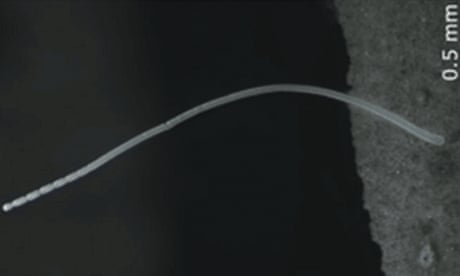- by foxnews
- 17 Mar 2025
Scientists discover world’s largest bacterium, the size of an eyelash
Scientists discover world’s largest bacterium, the size of an eyelash
- by theguardian
- 24 Jun 2022
- in news

Scientists have discovered the world's largest known bacterium, which comes in the form of white filaments the size of human eyelashes, in a swamp in Guadeloupe.
At about 1cm long, the strange organism, Thiomargarita magnifica, is roughly 50 times larger than all other known giant bacteria and the first to be visible with the naked eye. The thin white strands were discovered on the surfaces of decaying mangrove leaves in shallow tropical marine marshes.
The discovery was a surprise because, according to models of cell metabolism, bacteria should simply not grow this big. Previously scientists had suggested an upper possible size limit about 100 times smaller than the new species.
"To put it into context, it would be like a human encountering another human as tall as Mount Everest," said Jean-Marie Volland, a scientist at Lawrence Berkeley National Laboratory who co-authored the study.
"When I saw them, I thought: strange," said Gros. The lab first conducted microscopic analyses to establish that the strands were single cells. Closer inspection also revealed a strange internal structure. In most bacteria, the DNA floats around freely inside the cell. Thiomargarita magnifica appears to keep its DNA more organised inside membrane-bound compartments throughout the cell. "And this is very unexpected for a bacterium," said Volland.
The bacterium was also found to contain three times as many genes as most bacteria and hundreds of thousands of genome copies spread throughout each cell, making it unusually complex.
Scientists are not yet sure how the bacteria evolved to be so big. One possibility is that it adapted to evade predation. "If you grow hundreds or thousands of times bigger than your predator you cannot be consumed by your predator," said Volland.
However, becoming big would have meant losing some of bacteria's traditional advantages, including being uniquely able to move around and colonise new niches. "By leaving the microscopic world these bacteria have definitely changed the way they interact with their environment," said Volland.
The bacteria have not yet been found in other locations - and had disappeared from the original site when the researchers returned recently, perhaps because they are seasonal organisms. But in the paper, published in the journal Science, the authors conclude that the discovery "suggests that large and more complex bacteria may be hiding in plain sight".
- by foxnews
- descember 09, 2016
Rare artifacts representing America's 250th birthday will be featured in major exhibition
Rare artifacts will be featured in the "Give Me Liberty" exhibit at the Virginia Museum of History & Culture in Richmond to commemorate America's upcoming 250th anniversary.
read more


